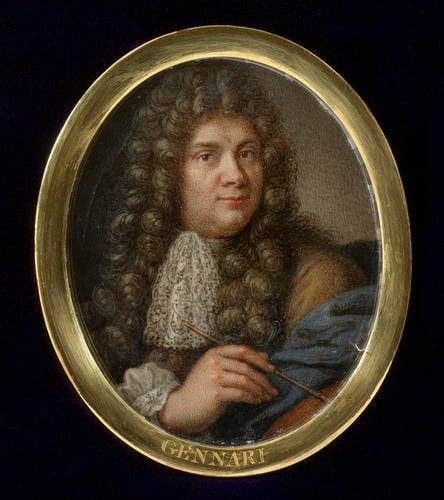Giuseppe Macpherson (1726-c. 1780)
Benedetto Gennari (1633-1715) c.1770-80
7.0 x 5.7 cm (sight) | RCIN 421272
-
Benedetto Gennari (1633-1715) came from a family of painters and was born in Cento, near Ferrara. His uncle was the artist Giovanni Francesco Barbieri, known as Guercino. In 1643, the family moved to Bologna where Guercino was already established. In 1672, Gennari travelled north and worked in Paris. From the autumn of 1674, he moved to England where James, duke of York, had recently married the Italian Mary of Modena and they became Gennari's most important patrons. He also received important commissions from King Charles II, for whom he provided mythological paintings for the new apartments at Windsor Castle, and from James II, for whom he decorated the new Catholic chapel at Whitehall in 1686–7. With the revolution of 1688, Gennari left England and accompanied the court in exile to Saint-Germain-en-Laye, where he stayed until 1692. He produced over 160 works during this period away from Italy, including religious and mythological paintings as well as portraits. He was acknowledged by James II as his first painter, and this was renewed by his son James Stuart in December 1701. There are a number of paintings by Gennari in the Royal Collection. When he returned to Italy, his sophisticated style made his work very popular and he continued to paint until the age of 76. The following year, in 1710, he became a founding member of the Accademia Clementina in Bologna, devoted himself to teaching, and was nominated director of the scuola de nudo (school of the nude).
This miniature is one of the collection of copies of 224 self-portraits by artists in the Uffizi Palace, Florence, that Lord Cowper, the art collector and patron, commissioned Giuseppe Macpherson (1726-1780) to paint. He presented the miniatures to King George III in two batches, in 1773 and 1786. Macpherson followed the original self-portraits quite closely, but copied only the head and shoulders. He inscribed the artists' names on the backs of the miniatures – several differ from those in the modern Uffizi catalogue, notably: Bazzi, Bellini, Campi, Annibale Carracci, Gabbiani, Masaccio, Metsys, Moroni, Pencz, Licinio, Schiavone and Spada. None of the miniatures is signed, apart from Macpherson's own self-portrait, which is inscribed: Giuseppe Macpherson / Autore della serie (Giuseppe Macpherson / Author of the series).Macpherson was born in Florence, the son of Donald Macpherson, a footman in the service of Alexander, 2nd Duke of Gordon. He was a pupil of Pompeo Batoni and painted miniatures and enamel portraits in Italy, France and Germany, finally settling in Florence. A James Macpherson is recorded in London and Paris in 1754 but it is not certain that this is the same person. He was described in 1776 as having a special talent for painting on enamel and as being 'almost the only painter in Europe who possesses this art to perfection'. He had a distinguished client list which included some of the crowned heads and dignitaries of Europe. In 1778, he was invited to add his own self-portrait to the famous painters in the grand duke's collection as it 'would do honour to Florence to enrich the collection with a work which shows that we still have some men of true merit' according to Giuseppe Pelli, director of the Uffizi at the time.Provenance
Presented to George III by Lord Cowper.
-
Creator(s)
-
Medium and techniques
Measurements
7.0 x 5.7 cm (sight)










